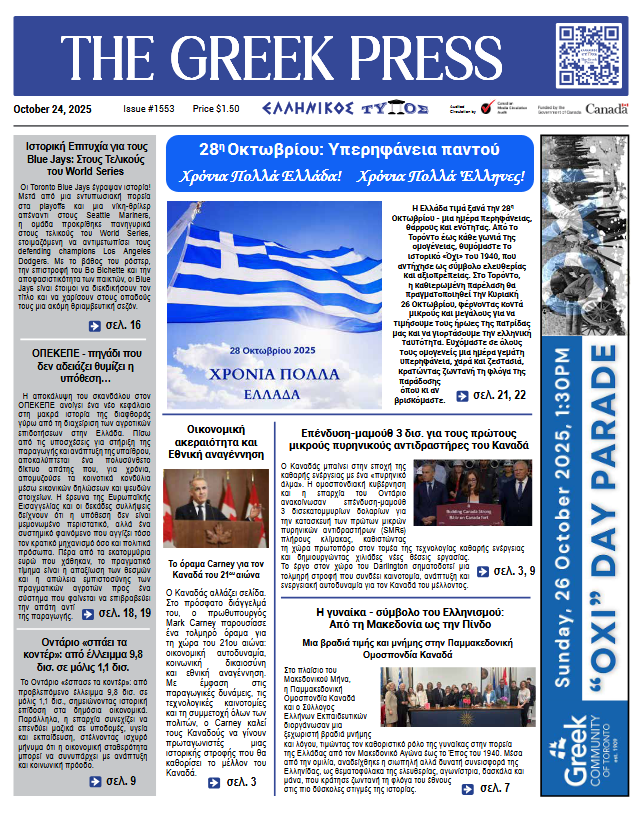 CLICK TO VIEW THE WHOLE PUBLICATION ONLINE
CLICK TO VIEW THE WHOLE PUBLICATION ONLINEΣτις 11:00 π.μ. 11Νοεμβρίου 1918, «την ενδέκατη ώρα, τηςενδέκατης μέρας, του ενδέκατου μήνα» όπως αναφέρεται αρκετές φορές από τον τύποη χρονική στιγμή έναρξης της συνθήκης ανακωχήςτων συμμάχων με τη Γερμανία της Κομπιέν (Compiègne), έληξε και επίσημα ο Πρώτος Παγκόσμιος Πόλεμος.
Η επέτειος εορτάζεται με κατάθεση στεφάνουστο μνημείο Αγνώστου Στρατιώτη από ανώτατους εκπροσώπους των αρχών και κατάπαράδοση με δύο λεπτών σιγή που αρχίζει στις 11:00 π.μ. της 11ης Νοεμβρίου, γιανα δοθεί φόρος τιμής στα 20 εκατομμύρια νεκρούς του Πρώτου Παγκοσμίου Πολέμου.
Η κόκκινη παπαρούνα υιοθετήθηκε σαν σύμβολο της Remembrance Day, λόγω του ποιήματος «In Flanders Fields» (1915) του Καναδού ποιητή John McCrae, ο οποίος πολέμησε στον Α’ Παγκόσμιο Πόλεμο. Ο μύθος θέλει τα πεδία των μαχών στην ευρύτερη περιοχή της Φλαμανδίας, στο Βέλγιο, να γεμίζουν με ανθισμένες παπαρούνες με το τέλος των εχθροπραξιών. Είναι γνωστό άλλωστε στην Αγγλία το ποίημα «Στα λιβάδια της Φλάνδρας» («Ιn Flanders field»), που έγραψε το 1915 ο υπολοχαγός Τζον ΜακΚρέι, προς τιμήν ενός φίλου του που σκοτώθηκε στη μάχη, και αναφέρεται στις παπαρούνες που άνθισαν εκείνο το Μάη, στο μέτωπο. Ο ΜακΚρέι πρόσεξε τότε πως οι παπαρούνες ήταν το πρώτο άνθος που άρχισε να φυτρώνει στα έως τότε καμμένα λιβάδια του Βελγίου, ενώ το κόκκινο χρώμα έχει καθιερωθεί προς τιμήν του αίματος που έχυσαν στα πεδία των μαχών αρκετά εκατομμύρια στρατιώτες.
Remembrance Day 2019
Canadiansrecognize Remembrance Day, originally called Armistice Day, every 11 Novemberat 11 a.m. It marks the end of hostilities during the First World War and anopportunity to recall all those who have served in the nation’s defence.
ArmisticeDay
Armistice Daywas inaugurated in 1919 throughout much of the British Empire, but on thesecond Monday in November. In 1921, the Canadian Parliament passed an ArmisticeDay bill to observe ceremonies on the first Monday in the week of 11 November,but this combined the event with the Thanksgiving Day holiday. For much of the1920s, Canadians observed the date with little public demonstration. Veteransand their families gathered in churches and around local memorials, butobservances involved few other Canadians.
In 1928, someprominent citizens, many of them veterans, pushed for greater recognition andto separate the remembrance of wartime sacrifice from the Thanksgiving holiday.In 1931, the federal government decreed that the newly named Remembrance Daywould be observed on 11 November and moved Thanksgiving Day to a differentdate. Remembrance Day would emphasize the memory of fallen soldiers instead ofthe political and military events leading to victory in the First World War.
11 November
Remembrance Dayrejuvenated interest in recalling the war and military sacrifice, attractingthousands to ceremonies in cities large and small across the country. Itremained a day to honour the fallen, but traditional services also witnessedoccasional calls to remember the horror of war and to embrace peace.Remembrance Day ceremonies were usually held at community cenotaphs and warmemorials, or sometimes at schools or in other public places. Two minutes ofsilence, the playing of the Last Post, the recitation of InFlanders Fields, and the wearing of poppies quickly became associated withthe ceremony.
Remembrance Dayhas since gone through periods of intense observation and periodic decline. The50th anniversary of the end of the Second World War in 1995 marked a noticeableupsurge of public interest, which has not ebbed in recent years. It is now anational holiday for federal and many provincial government workers, and thelargest ceremonies are attended in major cities by tens of thousands. Theceremony at the National War Memorial in Ottawa is nationally televised, whilemost media outlets – including newspapers, magazines, radio and televisionstations, and internet sources – run special features, interviews, orinvestigative reports on military history or remembrance-related themes.
The red poppy, anative plant along much of the Western Front during the First World War, hasbecome a powerful symbol of remembrance. It is the principal emblem of theRoyal Canadian Legion, which distributes several million each year to be wornby Canadians on Remembrance Day.
“InFlanders Fields the Poppies Blow…”
The familiarsymbol of the poppy owes much of its fame to Canadian poet and soldier JohnMcCrae. In Flanders Fields, McCrae’s best-known poem, was inspiredby and made reference to the poppies which grew along the Western Front. Itopens, “In Flanders fields the poppies blow / Between the crosses, row on row…”
The blood-redpoppy had long been associated with the fighting armies of Europe, and theflowers often overgrew the mass graves left by battles. During the First WorldWar, enormous artillery bombardments completely disrupted the landscape,infusing the chalk soils with lime. The poppies thrived in the environment,their colours standing out against the blasted terrain.
An EnduringSymbol
In 1921, theGreat War Veterans’ Association, the largest of several Canadian veteransgroups, adopted the poppy as a symbol of remembrance. The Canadian Legion,formed in 1925, continued this connection. The poppy was worn on the left lapeland close to the heart to recognize the sacrifice of soldiers in times of war.They were initially made by disabled veterans and the proceeds of sales, thenand now, go towards funding veterans’ needs.
The poppy remains an enduring symbol of remembrance in Canada, Great Britain, the nations of the Commonwealth, and in the United States for those who served or fell in service of their country.








































